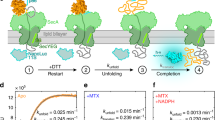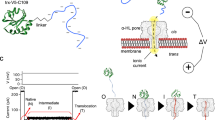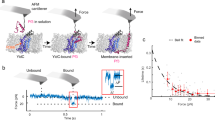Abstract
Membrane proteins destined for insertion into the inner membrane of bacteria or the endoplasmic reticulum membrane in eukaryotic cells are synthesized by ribosomes bound to the bacterial SecYEG or the homologous eukaryotic Sec61 translocon. During co-translational membrane integration, transmembrane α-helical segments in the nascent chain exit the translocon through a lateral gate that opens toward the surrounding membrane, but the mechanism of lateral exit is not well understood. In particular, little is known about how a transmembrane helix behaves when entering and exiting the translocon. Using translation-arrest peptides from bacterial SecM proteins and from the mammalian Xbp1 protein as force sensors, we show that substantial force is exerted on a transmembrane helix at two distinct points during its transit through the translocon channel, providing direct insight into the dynamics of membrane integration.
This is a preview of subscription content, access via your institution
Access options
Subscribe to this journal
Receive 12 print issues and online access
$189.00 per year
only $15.75 per issue
Buy this article
- Purchase on Springer Link
- Instant access to full article PDF
Prices may be subject to local taxes which are calculated during checkout




Similar content being viewed by others
References
White, S.H. & von Heijne, G. How translocons select transmembrane helices. Annu. Rev. Biophys. 37, 23–42 (2008).
Hessa, T. et al. Recognition of transmembrane helices by the endoplasmic reticulum translocon. Nature 433, 377–381 (2005).
Hessa, T. et al. Molecular code for transmembrane-helix recognition by the Sec61 translocon. Nature 450, 1026–1030 (2007).
Schow, E.V. et al. Arginine in membranes: On the connection between molecular dynamics simulations and translocon-mediated insertion experiments. J. Membr. Biol. 239, 35–48 (2011).
Ito, K., Chiba, S. & Pogliano, K. Divergent stalling sequences sense and control cellular physiology. Biochem. Biophys. Res. Commun. 393, 1–5 (2010).
Sarker, S., Rudd, K.E. & Oliver, D. Revised translation start site for secM defines an atypical signal peptide that regulates Escherichia coli secA expression. J. Bacteriol. 182, 5592–5595 (2000).
Nakatogawa, H. & Ito, K. Secretion monitor, SecM, undergoes self-translation arrest in the cytosol. Mol. Cell 7, 185–192 (2001).
Butkus, M.E., Prundeanu, L.B. & Oliver, D.B. Translocon “pulling” of nascent SecM controls the duration of its translational pause and secretion-responsive secA regulation. J. Bacteriol. 185, 6719–6722 (2003).
Chiba, S. et al. Recruitment of a species-specific translational arrest module to monitor different cellular processes. Proc. Natl. Acad. Sci. USA 108, 6073–6078 (2011).
Yap, M.N. & Bernstein, H.D. The translational regulatory function of SecM requires the precise timing of membrane targeting. Mol. Microbiol. 81, 540–553 (2011).
Muto, H., Nakatogawa, H. & Ito, K. Genetically encoded but nonpolypeptide prolyl-tRNA functions in the A site for SecM-mediated ribosomal stall. Mol. Cell 22, 545–552 (2006).
Garza-Sánchez, F., Janssen, B.D. & Hayes, C.S. Prolyl-tRNA(Pro) in the A-site of SecM-arrested ribosomes inhibits the recruitment of transfer-messenger RNA. J. Biol. Chem. 281, 34258–34268 (2006).
Gumbart, J., Schreiner, E., Wilson, D.N., Beckmann, R. & Schulten, K. Mechanisms of SecM-mediated stalling in the ribosome. Biophys. J. 103, 331–341 (2012).
Xie, K. et al. Features of transmembrane segments that promote the lateral release from the translocase into the lipid phase. Biochemistry 46, 15153–15161 (2007).
Yanagitani, K., Kimata, Y., Kadokura, H. & Kohno, K. Translational pausing ensures membrane targeting and cytoplasmic splicing of XBP1u mRNA. Science 331, 586–589 (2011).
Yap, M.N. & Bernstein, H.D. The plasticity of a translation arrest motif yields insights into nascent polypeptide recognition inside the ribosome tunnel. Mol. Cell 34, 201–211 (2009).
Nakatogawa, H. & Ito, K. The ribosomal exit tunnel functions as a discriminating gate. Cell 108, 629–636 (2002).
San Millan, J.L., Boyd, D., Dalbey, R., Wickner, W. & Beckwith, J. Use of PhoA fusions to study the topology of the Escherichia coli inner membrane protein leader peptidase. J. Bacteriol. 171, 5536–5541 (1989).
Dalbey, R.E. & Wickner, W. Leader peptidase of Escherichia coli: critical role of a small domain in membrane assembly. Science 235, 783–787 (1987).
Chou, P.Y. & Fasman, G.D. Prediction of protein conformation. Biochemistry 13, 222–245 (1974).
Nilsson, I.M. & von Heijne, G. Determination of the distance between the oligosaccharyltransferase active site and the endoplasmic reticulum membrane. J. Biol. Chem. 268, 5798–5801 (1993).
Nilsson, I., Whitley, P. & von Heijne, G. The C-terminal ends of internal signal and signal-anchor sequences are positioned differently in the ER translocase. J. Cell Biol. 126, 1127–1132 (1994).
Whitley, P., Nilsson, I.M. & von Heijne, G. A nascent secretory protein may traverse the ribosome/ER translocase complex as an extended chain. J. Biol. Chem. 271, 6241–6244 (1996).
Mingarro, I., Nilsson, I., Whitley, P. & von Heijne, G. Different conformations of nascent polypeptides during translocation across the ER membrane. BioMC. Cell Biol. 1, 3–10 (2000).
Bhushan, S. et al. SecM-stalled ribosomes adopt an altered geometry at the peptidyl transferase center. PLoS Biol. 9, e1000581 (2011).
Menetret, J.F. et al. The structure of ribosome-channel complexes engaged in protein translocation. Mol. Cell 6, 1219–1232 (2000).
Egea, P.F. & Stroud, R.M. Lateral opening of a translocon upon entry of protein suggests the mechanism of insertion into membranes. Proc. Natl. Acad. Sci. USA 107, 17182–17187 (2010).
Van den Berg, B. et al. X-ray structure of a protein-conducting channel. Nature 427, 36–44 (2004).
Johnston, S., Lee, J.H. & Ray, D.S. High-level expression of M13 gene II protein from an inducible polycistronic messenger RNA. Gene 34, 137–145 (1985).
Dalbey, R.E. & Wickner, W. Leader peptidase catalyzes the release of exported proteins from the outer surface of the Escherichia coli plasma membrane. J. Biol. Chem. 260, 15925–15931 (1985).
Dalbey, R.E. & Wickner, W. The role of the polar, carboxyl-terminal domain of Escherichia coli leader peptidase in its translocation across the plasma membrane. J. Biol. Chem. 261, 13844–13849 (1986).
Acknowledgements
We thank S. Bhushan and P.F. Egea for advice, and C. Lundin for technical assistance. This work was supported by grants from the European Research Council (ERC-2008-AdG 232648), the Swedish Foundation for Strategic Research, the Swedish Research Council, and the Swedish Cancer Foundation to G.v.H.
Author information
Authors and Affiliations
Contributions
N.I., R.H. and N.S. contributed to the study design, the experimental work and the writing of the paper. G.v.H. contributed to the study design and the writing of the paper.
Corresponding author
Ethics declarations
Competing interests
The authors declare no competing financial interests.
Supplementary information
Supplementary Text and Figures
Supplementary Figures 1–6 and Supplementary Tables 1 and 2 (PDF 18284 kb)
Rights and permissions
About this article
Cite this article
Ismail, N., Hedman, R., Schiller, N. et al. A biphasic pulling force acts on transmembrane helices during translocon-mediated membrane integration. Nat Struct Mol Biol 19, 1018–1022 (2012). https://doi.org/10.1038/nsmb.2376
Received:
Accepted:
Published:
Issue Date:
DOI: https://doi.org/10.1038/nsmb.2376
This article is cited by
-
The SecM arrest peptide traps a pre-peptide bond formation state of the ribosome
Nature Communications (2024)
-
Modulating co-translational protein folding by rational design and ribosome engineering
Nature Communications (2022)
-
A nascent peptide code for translational control of mRNA stability in human cells
Nature Communications (2022)
-
An epilepsy-causing mutation leads to co-translational misfolding of the Kv7.2 channel
BMC Biology (2021)
-
Context-specific action of macrolide antibiotics on the eukaryotic ribosome
Nature Communications (2021)



